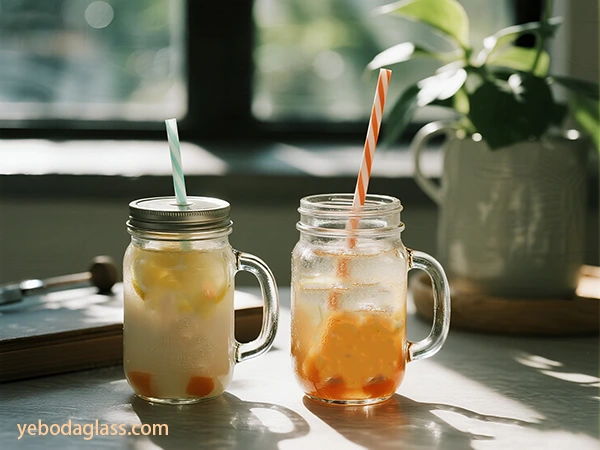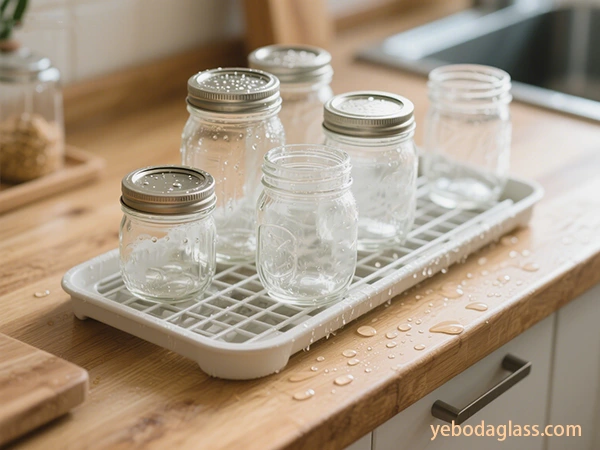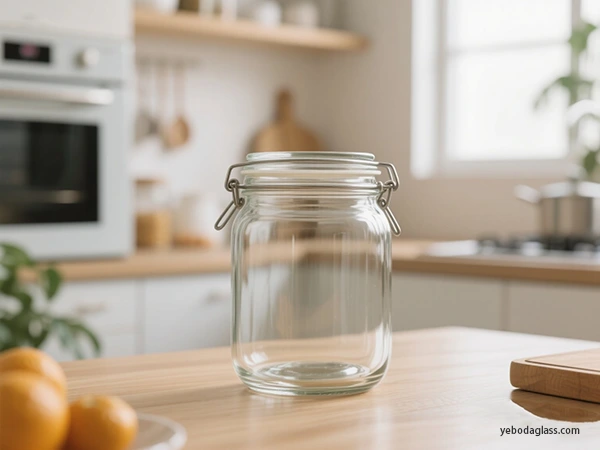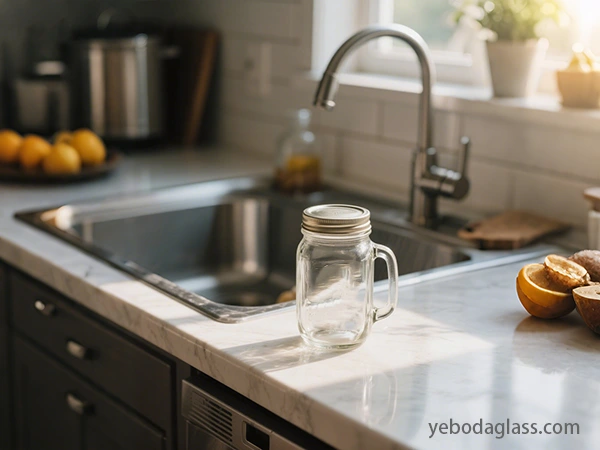Introdukcija
Traditional metal lids are disposable. Just wash them with hot soapy water. Never boil them, which will affect the seal. The screw caps can be reused, but those that are rusted or deformed must be thrown away. It is best to store them separately from the jars to avoid sticking and being unable to be removed.

Although reusable plastic lids (such as Tattler) are cost-effective, you must check whether the gasket is damaged every time and wash them with hot water according to the instructions.
There are some tips for drying after washing:
The jars must be completely dried before storage, otherwise they are prone to mold. Put them in a clean and dry place, don’t pile them directly, and cover them to prevent dust and bacteria. When filling the food at the end, remember to wipe the jar mouth and threads with a damp cloth – even a little food residue may cause the seal to fail!
Choose the right sterilization method
Not all situations require pre-sterilization, you have to choose according to your needs:
Situations where pre-sterilization is not necessary:
- As long as the canning is done in a boiling water bath for more than 10 minutes, or in a pressure can, the high temperature during the process is sufficient to sterilize, and there is no need to sterilize the empty cans separately in advance.
- Situations where pre-sterilization is necessary:
- When a boiling water bath is used to treat highly acidic foods for less than 10 minutes (such as jams and jellies), the empty cans must be sterilized first.
Recommended sterilization method:
Boiling water bath sterilization:
Recommended sterilization method:
Pressure canning (with built-in sterilization function):
This is a must for low-acid foods! During the process, both the food and the jars will be sterilized at the same time. The specific steps should be based on reliable recipes (such as the USDA canning guide).
Note: The sterilization mode of the dishwasher is not thorough enough, and oven sterilization is even more dangerous (it is easy to cause the jars to explode due to uneven heating). Neither is recommended!
Detailed steps: Follow the steps to sterilize properly
Boiling water bath sterilization
Prepare a large enough canning machine, put a rack at the bottom, and put the clean jars upright on it. Add hot water to cover the jars by 1 inch, cover and heat until boiling. Start the timer after the water boils and keep boiling for 10 minutes. Don’t take it out immediately after sterilization. Turn down the heat to keep the jars warm in hot water and take them out when you need them to prevent thermal shock.
Pressure canning
Just wash the jars, no need to sterilize in advance, keep them warm (put them in hot water or a warm oven).
Put hot food in, leave a suitable head space, wipe the jar mouth, put a new lid, and gently tighten the screw cap. Place the jars in the pressure canner, add the specified amount of water, cover but not pressurize, and heat to exhaust for 10 minutes. Pressurize to the specified poundage (adjusted according to altitude) according to the recipe, keep the pressure stable, and process for the specified time. Turn off the heat after processing, let the pressure canner cool naturally to zero, then open the lid to take out the jars and put them in a clean place to cool.
Keep it sterile: This is the right thing to do after sterilization

Now that you have learned how to sterilize mason jars, don’t let the last step ruin things! How you handle and store the sterilized jars is directly related to whether they will be contaminated with bacteria again, especially when you need to sterilize them in advance, you must be careless.
Use it while it's hot, don't wait for it to cool down
- The most important point is to use the sterilized jars that have just been taken out of boiling water, the oven or the dishwasher! This is emphasized by all methods and can avoid bacteria to the greatest extent. More than 1 hour? Re-sterilize
- If you really can’t use it immediately, don’t exceed 1 hour at most. Whether it is a jar, lid or screw cap, you have to sterilize it again after 1 hour; you can also soak the jar in hot water for temporary storage, but it can’t exceed 1 hour. Maintain temperature to prevent cracking and bacteria
Keep the jar warm before filling it, which can not only prevent cracking due to the large temperature difference when pouring hot food, but also help maintain a sterile environment. Either leave it in the sterilized hot water or put it in the oven at the lowest temperature to keep it warm, and take it out when you are ready to fill it.
- Don't make these small moves Remember to wear gloves or use jar clips when handling hot jars, and put them on a clean towel or cooling rack, not directly on a cold countertop (it is easy to crack). Also! After sterilization, never touch the inside of the jar and the sealing surface of the lid!
- These situations attract bacteria The surrounding environment is dirty, the jar is placed on a dirty rag, bacteria may take the opportunity to sneak in; after the jar is cooled, there are water droplets, which is a “nest” for bacteria.
Safety Tips & Canning Best Practices
When sterilizing mason jars (aka how to sterilize mason jars) and canning, these details are directly related to food safety, so remember them!
Don't change the recipe, follow the "standard answer"
Canning safety depends on scientifically proven recipes – it will clearly state whether to use a boiling water bath or pressure canning, how long to cook, and how much pressure (if necessary). Especially for low-acid foods, don’t add untried ingredients such as butter, flour, and rice, which will affect the heating effect and may make the food dangerous.
Dedicated jars are reliable
Always use mason jars and tools specifically for home canning! “Part-time” containers such as mayonnaise bottles and salad dressing bottles will not work. They can’t withstand the high temperature and pressure during canning, are easy to crack, and may not seal well.
Check the lid of the jar first
Uzturēt toks: Šī ir pareiza lieta pēc steriliācijas
Šeit jūs mācījāties, kā steriliizēt mason glāses, nebūt nešķērt pēdējo soli! Kā jūs apkalpot un glabājat steriliizētas glāses, ir tieši saistīts ar to, vai tās vēlreiz inficēsies ar baktērijām, īpaši kad jums ir jāsteriliizē dažāds priekšmetu, jums nekavējoties.
Lieto to, kamēr tas ir siltāks, nekavējoties, līdz kūpinās
Vis svarīgākais punkts ir lietot sterilizētās glāses, kas ir tikai izņemtas no bojātās ūdens, ugunskamera vai rūpniecības šūpoņa! Visi metodi to piemin un tas var ierobežot baktēriju ienākšanu vismazākā mērā.
Vairāk par 1 stundu? Atkārtoti sterilizēt
Ja jums patiesi nemaz nevar izlietot, nekavējoties, nepārsniegt 1 stundu. Zināt, vai glāse, virsma vai kāpnieks, jums jāsteriliizē atkārtoti pēc 1 stundas; arī var ieliet glāsei siltā ūdenī pagaidu glabāšanai, bet tas nekavējoties, nepārsniegt 1 stundu.
Uzturēt temperatūru, lai pārtraukt šķiedrām un baktēriju ienākšanu
Uzturēt glāsi siltu pirms tās aizpildīšanas, tas ne tikai var ierobežot šķiedrām, kad pēkšņi ievilkt siltu ēdienkarti, bet arī palīdz uzturēt steriliālu vidi. Varētu atstāt to steriliizētā siltā ūdenī vai ieliekt ugunskamerā zemākā temperatūrā, lai uzturētu siltumu, un ielietot, kad jūs gatavs to aizpildīt.
Neveic šīs mazās kustības
Atcerēties, ka, apstrādājot siltas glāses, jums ir jādod rīki vai izmanto glāses kāpnīcas, un ielietot tās čistā rīks vai sildāmo rāmu, nevis tieši uz aukstās pārklājuma (tas viegli šķīst). Arī! Pēc sterilizācijas neierakstīt glāzes iekšpusi un virsmu!
Šie situācijas piesaista baktēriju
Apkārtnē ir smurta, glāse ir novietota uz smurto rīks, baktērijas var izmantot iespēju ienākt; pēc glāzes sildīšanas ir šķidruma dzīšanas, kas ir “pūķis” baktēriju.

Drošības tipsi un glāsēm pārklāšanas labākā prakse
Pirms steriliizēšanas mason glāsēm (t.i. kā steriliizēt mason glāses) un glāsēm pārklāšanai, šie detalji ir tieši saistīti ar pārtikas drošību, tāpēc atcerējieties!
Ne mainīt recepti, izvēlieties "standardu atbildi"
Glāsēm pārklāšanas drošība ir atkarīga no pētījumu pierādītajām receptēm – tas skaidri norāda, vai izmantot bojātās ūdens bādīt vai spiediena glāsēm pārklāšanai, cik ilgi gatavot un cik spiediena (ja nepieciešams). Īpaši augstu skābu ēdieniem, nekavējoties, neiekliedzēt neizvērtu sastāvdaļas, piemēram, buteru, mīklas un rižus, kas var ietekmēt sildīšanas efektu un var izkārtot ēdienkarti.
Mūsu glāses ir drošas
Vienmēr lietot mason glāses un rīkus, kas paredzēti mājas glāsēm pārklāšanai! "Pilnvērtīgās" ierakuves, piemēram, mayonnaises butiņi un salātes skābekļu butiņi, nekavējoties, nekārtos. Tie nesaprot augstu temperatūru un spiedienu glāsēm pārklāšanai, viegli šķīst un var nesildīties labi.
Pirms tam pārbaudīt glāzes virsmu
Pārbaudiet butiņu apmēram pirms katras izmērījuma; labāk ir izmantot jaunu metālisko kapos (izmērījamie ir drošākie) un izvēlēties modeli, kas atbilst ražotāja rekomendācijām; lai gan virsmas kapos var atkārtoti izmantot, izlādīt rūsējošos un izmainījusies vienumus līdzvērtīgi.
Virsmas kapo apstrādē ir dažādas īpašības
Pašreizējais metālais kapums nepieciešami nesildīt, tikai šķīst; tas ir tāpat ar virsmas kapos, šķīst un pārbaudiet pirms izmērījuma.
Lietot butiņu, kad tas ir siltāks, lai pēc tam nesildītu un pildītu
Pirms sildīta ēdienas ieliekšanas, saglabāj butiņu siltu (piemēram, ieliekot sterilizētā siltās ūdenī vai sildot zemā temperatūrā piekūpē) lai izvērstos drīzās sildīšanās dēļ, un tas arī palīdz saglabāt sterilienu vidi.
Šķīst butiņa rītiņu, lai salsdētu
Pēc ēdienas ieliekšanas, droši šķīst butiņa rītiņu, lai kapums varētu salsdēt stipri un ne viegli bojāt.
Dzinējspiedienu panīsst pilnībā
Lietojot dzinējspiedienu, pēc instrukcijām izvērsiet gaisu, lai sasniegtu nepieciešamo temperatūru un sterilizācija būtu pilnīgāka.
Augstums augsts? Dzinējspiedienu laiku jāpārdomā
Ūdens burkšņošanās temperatūra ir atšķirīga atkarībā no augstuma. Ja dzīvojat augstā augstumā, ūdens burkšņošanās laika vai dzinējspiedienu spiediena jāpārdomā atbilstoši, otherwise the sterilization will not be thorough.
Lietot butiņas, būjat prāts, lai nesildītu roku
Lietot butiņu pēdas vai uguns sapērēm, lai ņemtu siltās butiņas, būjat stabili, nesildījat vai nevirzījat tos.
Pārbaudiet slēdzi pēc vēršanās
Pēc konservēšanas ieliekat ērtā vietā, lai pildītu dabiski, un pēc tam pārbaudiet kapos – ja centrā ir iekšēja paugurīte un, kad to uzskaļ, ir skrējiens, tas ir salsdēts; ja nesalst, ieliekat reāģierī ātri, vai pārveidojat to.
Drošākā glabāšanas vidi ir siltā un miera
Salsdētiem konservētiem pārtikas produktiem jāieliek siltā, miera un tumsā vietā, temperatūra ir starp 10°C un 21°C. Neskaidrie to saulē, un nesmētu kelt piešķirtu starp siltumu un vēsumu, lai tie varētu ilgi glabāties un tās varētu ēst ar uzticamību.

Atslēga
Ja vēlaties uzzināt, kā steriliizēt mason butiņas un glabāt pārtiku mājās, ir svarīgi izvēlēties pareizo butiņu! No atšķirības starp steriliizāciju un sterilizāciju, līdz izvēlēšanai starp ūdens burkšņošanu vai dzinējspiedienu pēc sastāva, līdz precīzai šķīšanai un pārbaudēm – katrs solis nevar būt neprātīgs. Saskaņojoties ar autoritātu organizāciju (piemēram, USDA un NCHFP) norādījumiem, un izvairot neuzticamas metodes, piemēram, uguns sterilizāciju, lai konservētie produkti varētu ēst ar uzticamību.
Un YEBODA mason butiņas ir jūsu uzticamais partneris:
- Laba stikla, drošāk: pārtikas kvalitātes, nesildāmās stikla, specifiski pārstrādāts, sildījams un spiediens, var izturēt ūdens burkšņošanu un dzinējspiedienu, nesildās viegli, un lietošanā uzticami.
- Precīzā augšana, stabilā slēdzi: butiņas rītiņa izmērs un virsmas virsmas tieši atbilst standartiem, pilnīgi saprot dažādām kapos un virsmas kapos, un slēdzi ir pilnīgi uzticama, kas ir klītība garu pārtikas glabāšanai.
- Izturīgs un dabīgs: ar labu šķīšanu un uzturēšanu, tas var izmantot daudzus gadus, iekšēji un dabīgi.
- Tas ir daudzlietots un ērtš: tas ne tikai var lietot konservēšanai, bet arī glabāt sauszemes produktus, raistīt, glabāt reāģierī, pagatavot dzērienus un pat kā dekorāciju. Tas var lietot dažādās mājas situācijās.
Izvēlēties YEBODA mason butiņas nozīmē izvēlēties drošību, uzticamību un augstu kvalitāti. Vai jūs precīzāk vēlaties savu ģimenes mieru, tāpēc mēs iesildam katru butiņu, lai jūs varētu uzticamību katras reizes, kad jūs varētu glabāt un apmācīties mājas ēdienu ērtību. No šķīšanas, sterilizācijas līdz glabāšanai, tas ir kādas palīgas, ko jūs nesvarētu pazemt no kūpēm!

